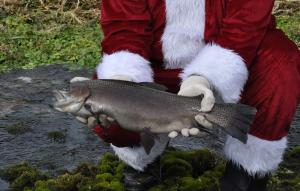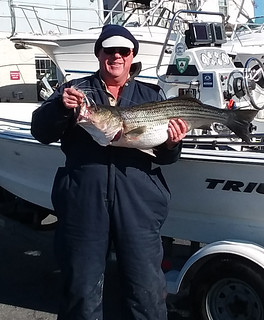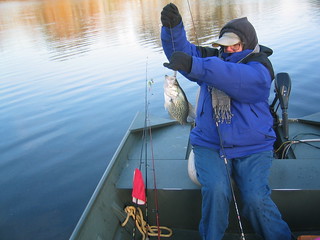Maryland Fishing Report: Dec. 12
 This will be our last fishing report for 2018, but we will return in mid-January with a report on winter fishing activities and some news about upcoming outdoor shows.
This will be our last fishing report for 2018, but we will return in mid-January with a report on winter fishing activities and some news about upcoming outdoor shows.
The 2018 striped bass season closes Dec. 15. The season ends a few days earlier than last year, as part of the conservation-minded regulations that included reducing the minimum length for Chesapeake Bay rockfish to 19 inches. The Potomac River below the Woodrow Wilson Bridge will be open to striped bass fishing until Dec. 31. Our readers should also keep in mind that there are other species that will still be in season for die hard cold-weather anglers.
Happy holidays from everyone at the Maryland Department of Natural Resources!
Forecast Summary: Dec. 12 – 18
With Chesapeake Bay temperatures at the low 40s and dropping, fish are moving towards or already have found their winter holding areas, or are migrating out of the bay. With plenty of cool waters and oxygen from surface to bottom, anglers can look for concentrations of fish in some of the remaining warm water areas. In the main bay, warmer bottom waters are located below the Bay Bridge south to near the Maryland State line, in areas below 50 feet with good structure such as underwater points, oyster bottom, reefs, channel edges, and with large schools of baitfish. Other warm spots are near the water discharges of your local power plants.
Temperatures will be cool with a slight warming to the 50s and rain on Friday and Saturday. The rest of the week expect sunny to partly cloudy conditions, with daytime air temperatures in the mid 40s and night-time temperature in the 30s. At the National Oceanic and Atmospheric Administration and Maryland Department of Natural Resources buoys, water temperatures continue to cool, with Thomas Point at 39 degrees, Mallows Bay at 39 degrees and Point Lookout at 43 degrees. Due to continued higher-than-normal flows, there is still poor water clarity on the main bay down to Bay Bridge and on the Potomac River down to near Colonial Beach. There will be above average tidal currents all week as we approach the full moon Dec. 22.
For the full weekly fishing conditions summary and more, please be sure to check out Click Before You Cast.
The water releases at the Conowingo Dam have slowed down recently to lower than average for this time of the year. Those fishing in the lower Susquehanna River and the mouth of the Northeast River are still catching a few legal-sized striped bass. Many are now focusing on yellow perch, which are being caught in deep water on small jigs and minnows on dropper rigs, and can also be found in the Chester and Middle rivers. Channel catfish can be found holding in the same areas and can be caught on a variety of baits.
Surface water temperatures in the upper bay are in the lower 40s and in the 30s in the tidal rivers, bit warmer water can be found on the bottom in the deepest channels. This is where striped bass and white perch are lying.
Trolling with heavy inline weights to get down to depths below 35 feet are the best option to search for a striped bass that might be interested in taking a lure. Umbrellas rigs, single and tandem-rigged bucktails dressed with sassy shads have been the most popular items to troll in chartreuse or pearl.
Jigging is another option with soft plastic jigs in the channels, when fish can be spotted on depth finders. The deeper bridge piers at the Francis Scott Key Bridge and the Bay Bridge are two of the best places to jig on the striped bass holding there. Most are using larger soft plastic jigs in chartreuse or pearl.
White perch can be found holding in the same deep waters near bridge piers or rock piles as well as deep channels. Most anglers are using dropper rigs to get down to them and hold bottom, but a two hook bottom rig will also work well. Both rigs need a little enticement added in the form of pieces of bloodworms on small jigs or hooks.

Mark Hanson caught this striped bass while trolling near Bloody Point recently. Photo courtesy of Mark Hanson
Cold water temperatures have put the skids to the last few days of the season. Striped bass are holding close to the bottom in some of the deepest parts of the bay where water temperatures are slightly warmer. They can be spotted on a depth finder but getting them to bite is an entirely different situation.
Trolling has been a popular method to cover the deep areas where striped bass are holding with heavy inline weights. Umbrella rigs and single or tandem rigged bucktails dressed with sassy shads have been popular. Bloody Point, the mouth of Eastern Bay, the False Channel and the western side of the shipping channel have been a few of the places to give trolling a try. Jigging with large soft plastic jigs can also be tried in these same areas.
The warm water discharge at the Calvert Cliffs Power Plant is always a good spot and striped bass can often be found there. Drifting in the discharge current and jigging with metal or soft plastic jigs is very popular. A variety of other fish can also be found seeking a little warmth. Speckled trout often hold there in fall and American shad in early spring.
White perch offer some action, holding over hard bottom in the deeper parts of the bay, often near the mouths of the region’s tidal rivers. Bottom rigs or dropper fly rigs are the best way to get to them and pieces of bloodworms on the jig flies or hooks get the best results.
This region offers some of the best opportunities for catching the last few striped bass before the season closes Dec. 15. The Potomac River and its tributaries on the Maryland side of the river, from the Woodrow Wilson Bridge to the mouth of the river, will be open to striped bass fishing until Dec. 31.
The deeper areas of the lower Potomac near St. Georges Island and out to the mouth of the river and Smith Point have been some of the better places to fish for striped bass that are holding deep. The eastern side of the shipping channel near Buoys 72 and 72A have also been holding some fish.
Trolling and jigging are the two popular ways to fish, but in both cases one needs to get down to the bottom-hugging fish in 35 feet or more of water. Heavy inline weights or downriggers are being used to get trolling rigs down to the fish. Umbrella rigs and single or tandem rigged bucktails or parachutes dressed with sassy shads in chartreuse or pearl are the most common lures being used. A few reports of larger fall run striped bass near Smith Point have encouraged trolling anglers to place a few larger parachutes in their spread. Those jigging are using skirted soft plastic jigs that are 6 inches to 10 inches long in purple, pearl or chartreuse.
Fishing for white perch remains good in the lower Patuxent and Nanticoke rivers and other tidal rivers in the region. The perch are often holding in 40 feet of water or more, close to the bottom. Bottom rigs or dropper fly rigs are the most popular ways to get to those depths and hold bottom. The dropper flies and bottom rig hooks are tipped with pieces of bloodworm for the best results.
Fishing for blue catfish in the Potomac River below the Woodrow Wilson Bridge remains excellent. The Nanticoke and Patuxent rivers also offer fishing for blue catfish and channel catfish. Fishing for yellow perch in the upper sections of the Nanticoke River near the Marshyhope is reported to be good, as are other tidal rivers in the region.
 Trout fishermen will have something to look forward to in January as trout hatchery crews prepare for the pre-season stocking. The reports from the hatcheries are that they have some robust trout waiting for you, since the excellent water flows during the summer months aided growth. This is a good time to check out your fishing gear, especially those rubber boots and waders. Would-be anglers are encouraged to start checking out the trout stocking website. There is also a map to guide you to areas that are routinely stocked showing different trout management designations.
Trout fishermen will have something to look forward to in January as trout hatchery crews prepare for the pre-season stocking. The reports from the hatcheries are that they have some robust trout waiting for you, since the excellent water flows during the summer months aided growth. This is a good time to check out your fishing gear, especially those rubber boots and waders. Would-be anglers are encouraged to start checking out the trout stocking website. There is also a map to guide you to areas that are routinely stocked showing different trout management designations.
Reports say some ice has formed on Deep Creek Lake but is unsafe to venture out on it. Warmer weather is predicted for this weekend and the ice will most likely melt and break up. Fishing for yellow perch and walleye along the steep shorelines has been good with minnows under a slip bobber or fishing close to the bottom with a lip hooked minnow on a jig head.
Those fishing for largemouth bass are beginning to focus on working deep structure with a variety of jigs, crankbaits and a few blade lures to fish deep channel edges. One can expect the strikes to be light and more like a subtle pickup at times. Sunny shores during the day can be expected to draw largemouth bass looking for a little warmth and an extra bite to eat. Spinnerbaits, crankbaits and jerkbaits can be good choices when covering water in these areas.

A bundled up Lisa Hopps swings a nice crappie into the boat. Photo by Bill Hopps
Crappie fishing has been very good in the lakes and tidal rivers of Maryland this week. The crappie are schooled up in deeper waters near structure. Bridge piers, marina docks and fallen treetops are all great places to look for crappie. A simple slip bobber with a minnow or a small crappie jig are a good way to catch them.
Chain pickerel can provide plenty of action. They are very active in cold water and can be found in most ponds, lakes and tidal rivers. Fishing for channel catfish in the tidal rivers is good and there are abundant numbers of blue catfish in the tidal Potomac River.
Surf anglers have been patiently soaking large cut menhaden baits off the beaches of Ocean City and Assateague, anticipating the fall migration of striped bass passing our shores. Some striped bass are being caught with most measuring under the 28-inch minimum. A few are measuring over 30 inches, just enough to keep surfcasters coming back for more.
Striped bass are also being caught at the inlet to the Route 90 Bridge area. Trolling umbrella rigs or jigging has been a good way to catch them; others are casting bucktails from jetty and bulkhead areas with good success.
Tautog seem to be moving away from the waters of the inlet area as water temperatures dip to the mid-40s. Out at the wreck and reef sites the same behavior is being noted with sea bass. Captains report that the inshore sites hold mostly smaller sea bass, and the larger fish are moving to deeper offshore sites. The offshore tautog fishery is improving and some boats are now targeting them with good success.
“Our greatest trophies are not things, but times.” — Gene Hill
Keith Lockwood has been writing the Fishing Report since 2003 and has had a long career as a fisheries research biologist since 1973. Over the course of his career he has studied estuarine fishery populations, ocean species, and over a decade long study of bioaccumulation of chemicals in aquatic species in New Jersey. Upon moving to Oxford on the eastern shore of Maryland; research endeavors focused on a variety of catch-and-release studies as well as other fisheries related research at the Cooperative Oxford Laboratory. Education and outreach to the fishing public has always been an important component to the mission of these studies. Keith is an avid outdoorsman enjoying hunting, fishing, bird dogs, family and life on the eastern shore of Maryland.


 1-888-373-7888
1-888-373-7888 233733
233733